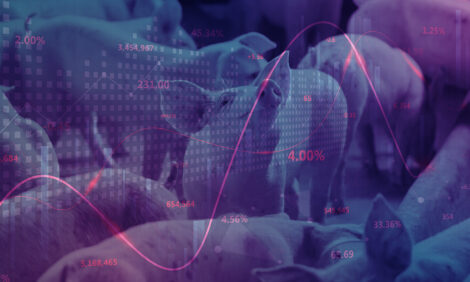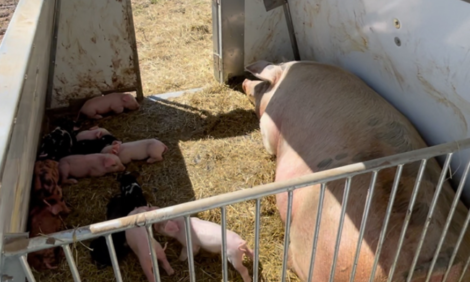



UK/EU Market Update - January 2002
By MLC - The end of 2001 market update from the UK's Meat and Livestock Commission (MLC) highlighting the continued fall in UK pig numbers and the fact that for most of 2001, UK pig meat prices were below the EU average.
MARKET PRICES
November saw sharply increasing pig prices in Great Britain as the
relaxation of the export restrictions began to impact on the market. The
average price in the week ended 1 December was 104p/kg dw, 9p more than four
weeks earlier. Prices also rose above year earlier levels in late November,
after being significantly lower during much of the summer and autumn
Between mid-September and the middle of November average EU prices
declined sharply, in marked contrast to the trend seen on the UK market.
Increasing EU production combined with some switch back to beef following the
BSE-induced slump in demand last year are likely to have been contributory
factors. In the second half of November, however, there was a recovery in EU
prices.
The export market normally accounts for over 90 per cent of UK sow meat
production and consequently the resumption of exports has had a more
significant impact on cull sow prices than on clean pigs. There are currently
some very significant regional differences in prices. Average prices are
around 23-26p/kg (£33-£38 per sow) but, in areas where export buying is
particularly strong, prices as high as 50p/kg (about £73/sow) have been
reported. Price levels of cull sows did not vary much during the course of
November, although in early December some slowdown in German import demand has
been reported.
For most of 2001, UK pig meat prices have been below the EU average, in
marked contrast to the UK price premium seen in 1999 and 2000. However weaker
EU prices in October meant that by the end of the month the UK price was once
again up to the EU average, and in November the UK price averaged 12p/kg above
the EU price. Looking forward to 2002, there could be downward pressures on EU
prices, as production is beginning to expand. EU production in 2002 could be
two per cent up on this year, with growth expected in Denmark and Germany.
 LINK: What are these prices and how are they calculated?
LINK: What are these prices and how are they calculated?
*Estimates
Weekly slaughtering levels in August began to increase, after being stuck
at the 190-195 thousand level for a couple of months. Slaughterings averaged
209,000 a week in September and an estimated 216,000 head by November. The
year-on-year decline averaged just eight per cent in November, but this is
only because clean pig slaughterings were being affected by Classical Swine
fever in East Anglia a year ago. The underlying rate of decline is still
fairly close to the levels seen in April-July.
 United Kingdom clean pig slaughterings look set to total about 10.5
million in 2001 as a whole, 15 per cent down on 2000 and the lowest annual
total since 1961. Some of this decline has been offset by an increase in
average carcase weights, but total pig meat production this year will still be
the lowest for 23 years
United Kingdom clean pig slaughterings look set to total about 10.5
million in 2001 as a whole, 15 per cent down on 2000 and the lowest annual
total since 1961. Some of this decline has been offset by an increase in
average carcase weights, but total pig meat production this year will still be
the lowest for 23 years
Sourced from:
|
| EU Pigmeat Prices | ||||
| Nov. 2000 (p/kg dw) | UK:EU | Nov. 2001 (p/kg dw) | UK:EU | |
| EU | 92.8 | +11.2 | 89.0 | +11.7 |
| United Kingdom | 104.0 | 100.7 | ||
| Netherlands | 85.8 | +18.2 | 79.0 | +21.7 |
| Denmark | 88.5 | +15.5 | 91.0 | +9.7 |
| France | 95.6 | +8.4 | 83.7 | +17.0 |
| Germany | 95.2 | +8.8 | 91.6 | +9.1 |

PRODUCTION
Between April and July, monthly clean pig slaughterings averaged 18-19 per cent lower than in the corresponding months of 2000. Over half of this was due to the contraction in the national breeding herd. In addition, it is estimated that around four per cent was the result of FMD restrictions and that the pig wasting diseases (PMWS and PDNS) had a similar impact.| Production Indicators | ||||
| Period | 2000 (000 head) |
2001* (000 head) |
% change | |
| Weekly ave clean slaughter | November | 235 | 216 | -8 |
| Weekly ave sow slaughter | November | 5.9 | 5.6 | -5 |

CONSUMPTION
Total consumption of pig meat this year has been adversely affected by supply shortages and higher retail prices as well as disruptions arising from Foot and Mouth Disease. Consumption across most segments of the market – fresh pork, bacon, processed pig meat as well as the foodservice sector – have been hit. Although retail purchases of pork and bacon were well down in the first seven months of the year, August saw volumes begin to move much closer to last year’s levels, although a sharp, downturn was recorded in November. In the year to 11 November, pork purchases were seven per cent less than a year earlier while bacon was down five per cent. However, because of higher retail prices, pork expenditure was unchanged in this period while bacon expenditure was eight per cent higher.OTHER NEWS
The European Standing Veterinary Committee (SVC) has decided that exports of pig meat from Poland to the EU will be permitted . Exports from Poland had not been authorised before due to concerns over animal health and in particular classical swine fever. However, the Polish authorities have implemented a control and surveillance programme against the disease and supplied the EU with the necessary information to prove absence of the disease in the country. Following China's accession to the WTO it is now taking steps within its meat and livestock industry to gain export confidence. China produces approximately 60 million tonnes of meat each year, making it the largest meat producer in the world. However, exports are only one per cent of this figure. The world market has often questioned China's disease, quarantine and prevention standards and this is the area China is now beginning to address. The agriculture ministry announced on Tuesday 27 November a scheme to devise five animal disease free zones by the end of 2001, within which it will protect livestock from FMD, swine fever and bird flu. This will be carried out under the strict criteria devised by the Office International Des Epizooties (OIE) and the WTO. It is hoped by the end of 2002 that these five zones will be ready for inspection by international countries and the OIE.





